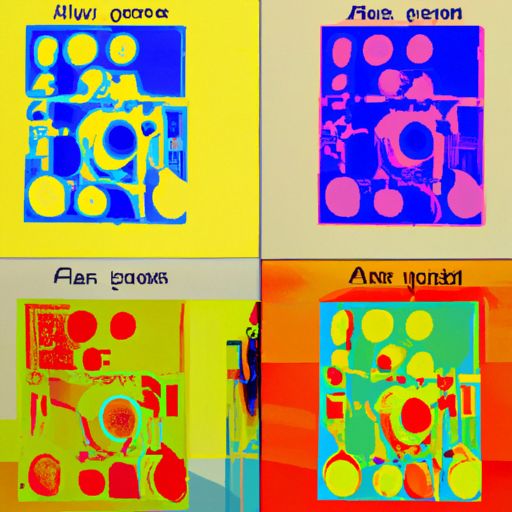
-
Table of Contents
- AI’s Role in Predictive Graphic Design Trends
- The Rise of AI in Graphic Design
- Case Study: Adobe Sensei
- Predictive Design Trends with AI
- 1. Color Palette Recommendations
- 2. Typography Suggestions
- 3. Image and Icon Recommendations
- The Benefits of AI in Predictive Graphic Design Trends
- 1. Time and Cost Efficiency
- 2. Data-Driven Decision Making
- 3. Staying Ahead of the Competition
- Conclusion
AI’s Role in Predictive Graphic Design Trends

Graphic design is an ever-evolving field that constantly adapts to new technologies and trends. With the rise of artificial intelligence (AI), designers now have access to powerful tools that can analyze data, predict trends, and assist in the creation of visually appealing designs. AI’s role in predictive graphic design trends is revolutionizing the industry, enabling designers to stay ahead of the curve and create designs that resonate with their target audience. In this article, we will explore the impact of AI on graphic design trends and how it is shaping the future of the industry.
The Rise of AI in Graphic Design
Artificial intelligence has made significant advancements in recent years, and its integration into graphic design has opened up new possibilities for designers. AI algorithms can analyze vast amounts of data, including social media trends, user preferences, and historical design patterns, to predict future design trends. By leveraging this predictive power, designers can create designs that are not only visually appealing but also aligned with the preferences of their target audience.
Case Study: Adobe Sensei
One notable example of AI’s impact on graphic design is Adobe Sensei, an AI-powered platform developed by Adobe. Sensei uses machine learning algorithms to analyze design trends and user behavior, providing designers with valuable insights and recommendations. For instance, Sensei can analyze the performance of different design elements in real-time, such as color schemes or typography choices, and suggest improvements based on user engagement data.
By utilizing Adobe Sensei, designers can save time and effort in the design process while ensuring their creations are optimized for maximum impact. This AI-powered platform empowers designers to make data-driven decisions and stay ahead of the competition by predicting and incorporating upcoming design trends.
Predictive Design Trends with AI
AI’s ability to analyze vast amounts of data enables it to identify patterns and predict future design trends. By understanding these trends, designers can create designs that resonate with their target audience and capture their attention. Let’s explore some of the ways AI is shaping predictive design trends:
1. Color Palette Recommendations
Color plays a crucial role in graphic design, evoking emotions and setting the tone for a design. AI algorithms can analyze color trends across various industries and demographics, helping designers choose color palettes that are likely to resonate with their target audience. By leveraging AI’s predictive capabilities, designers can create designs that are visually appealing and aligned with current and future color trends.
2. Typography Suggestions
Typography is another essential element of graphic design that can greatly impact the overall aesthetic and readability of a design. AI algorithms can analyze typography trends, font pairings, and user preferences to provide designers with suggestions for typography choices. By incorporating AI’s recommendations, designers can create designs that are visually appealing and optimized for readability.
3. Image and Icon Recommendations
Images and icons are powerful visual elements that can enhance the message of a design. AI algorithms can analyze image and icon trends, as well as user preferences, to recommend relevant and impactful visuals. By leveraging AI’s predictive capabilities, designers can select images and icons that resonate with their target audience, increasing the effectiveness of their designs.
The Benefits of AI in Predictive Graphic Design Trends
The integration of AI in graphic design brings numerous benefits to designers and the industry as a whole. Let’s explore some of the key advantages:
1. Time and Cost Efficiency
AI-powered tools can significantly reduce the time and effort required in the design process. By automating tasks such as trend analysis and recommendations, designers can focus more on the creative aspects of their work. This increased efficiency translates into cost savings for businesses and allows designers to deliver high-quality designs in shorter timeframes.
2. Data-Driven Decision Making
AI’s ability to analyze vast amounts of data empowers designers to make data-driven decisions. By leveraging AI-powered insights and recommendations, designers can create designs that are more likely to resonate with their target audience. This data-driven approach increases the chances of design success and reduces the risk of creating designs that do not align with user preferences.
3. Staying Ahead of the Competition
By utilizing AI’s predictive capabilities, designers can stay ahead of the competition by incorporating upcoming design trends into their work. This gives them a competitive edge and allows them to create designs that are fresh, relevant, and appealing to their target audience. By staying ahead of the curve, designers can establish themselves as industry leaders and attract more clients.
Conclusion
AI’s role in predictive graphic design trends is transforming the industry by enabling designers to create visually appealing designs that resonate with their target audience. Through AI-powered platforms like Adobe Sensei, designers can leverage data-driven insights and recommendations to optimize their designs for maximum impact. By analyzing color palettes, typography choices, and image recommendations, AI algorithms help designers stay ahead of the curve and incorporate upcoming design trends into their work.
The integration of AI in graphic design brings numerous benefits, including time and cost efficiency, data-driven decision making, and a competitive edge. As AI continues to advance, we can expect even more sophisticated tools and algorithms that will further revolutionize the field of graphic design. By embracing AI’s predictive capabilities, designers can unlock their creative potential and shape the future of graphic design.
